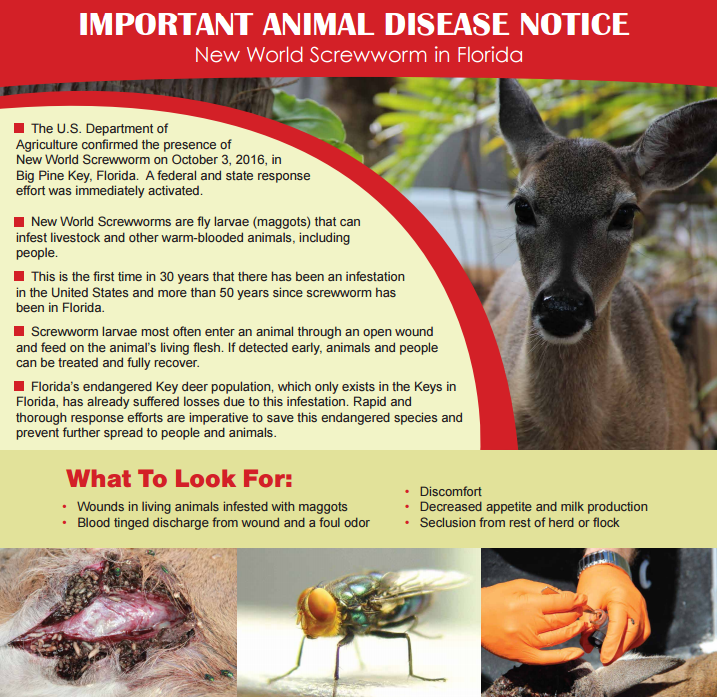In a screwworm update from Florida Department of Agriculture Commissioner Adam Putnam today, USDA, National Veterinary Services Laboratories, in Ames, Iowa, has confirmed 17 cases of screwworm since infestation was first detected.

The latest positive case was collected from a Key deer on Munson Island and confirmed on Jan. 10.
The U.S. Department of Agriculture (USDA), Florida Department of Agriculture and Consumer Services (FDACS) and partnering agencies have been executing an aggressive eradication program since Oct.
Concerning the eradication program for this infestation, the following information is made available:
- The U.S. Fish and Wildlife Services has been working with wildlife veterinarians to evaluate and select treatments to prevent healthy Key deer from becoming infested by screwworm, and to treat deer in the early stages of infestation. Deer are being marked with non-toxic paint to identify those who have been treated and treatments will continue until screwworm infestations have subsided.
- The release of sterile flies includes the following Keys: Big Pine Key, Big Torch Key, City of Marathon, Middle Torch Key, Little Torch Key, Cudjoe Key, Ramrod Key, No Name Key, Little Pine Key, Sugarloaf Key, and Summerland Key. Following the confirmation of a positive screwworm sample from a stray dog in Homestead, Fla., fly releases began in the Homestead area as a precautionary measure on January 13, 2017. To date, fly assessments have been conducted on 40 Keys and in the Homestead, Fla. area. USDA has released over 140 million sterile flies from 34 ground release sites on twelve islands, the city of Marathon and in the Homestead area.
- FDACS established an animal health check point at mile marker 106. Travelers moving north with pets, small animals or livestock must stop to get a free check for signs of screwworm. Early detection is key, and this disease can be treated.
- To date, 16,207 animals have been checked at the health check point- 14,941 dogs, 671 cats, 301 chickens, 1 other poultry, 123 parrots, 16 parakeets, 1 peafowl, 1 finch, 1 duck, 75 horses, 8 sea snails, 11 rabbits, 3 raccoons, 1 snake, 5 primates, 9 rodents, 5 opossums, 4 swine, 4 goats, 6 sheep, 2 llamas, 2 camels, 3 ferrets, 4 lizards, 1 hedgehog, 6 crabs, and 2 sugar gliders have had health checks completed at the check point with no signs of screwworm.
LISTEN: Screwworms: An interview with UF professor, Dr. Phillip Kaufman
Screwworm was first confirmed on October 3, 2016 in Key deer from National Key Deer Refuge on Big Pine Key, Florida. This initial presence of screwworm was the first local detection in the United States in more than 30 years and Florida’s Commissioner of Agriculture, Adam Putnam declared an agricultural state of emergency in Monroe County, Florida.
New World screwworms are fly larvae (maggots) that can infest livestock and other warm-blooded animals, including people. They most often enter an animal through an open wound and feed on the animal’s living flesh. While they can fly much farther under ideal conditions, adult flies generally do not travel more than a couple of miles if there are suitable host animals in the area. New World screwworm is more likely to spread long distances when infested animals move to new areas and carry the pest there.
Related: Florida screwworm: USDA releases interactive ‘Story Map’

